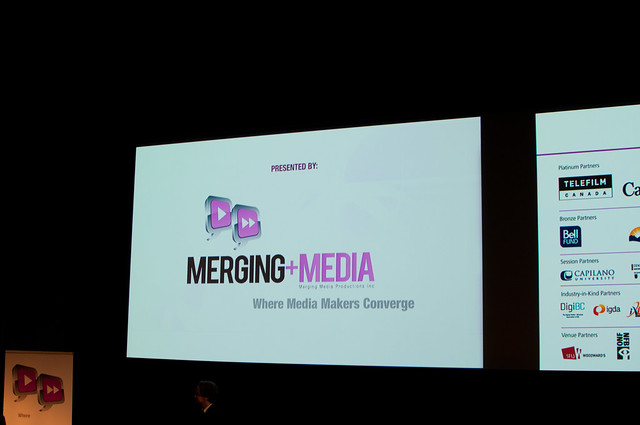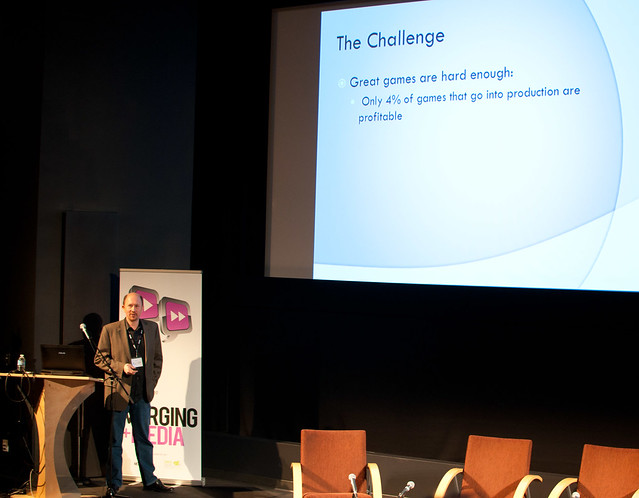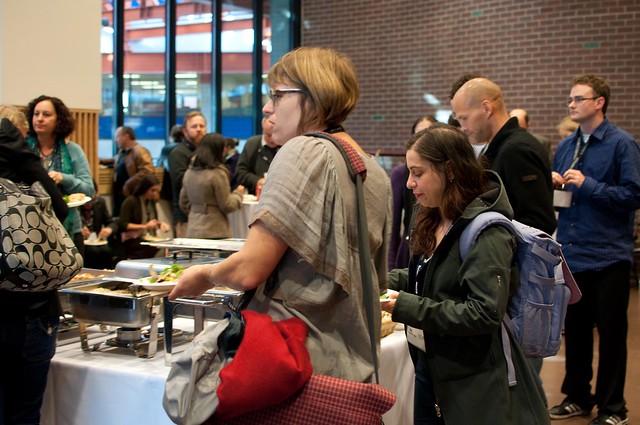Here’s a mash-up of yesterday’s Merging Media Conference panels and speakers, divided up into their respective sections. The two day event is taking place at SFU Woodwards Goldcorp Centre for the Arts, and has thus far proven a perfect opportunity to meet with talented gamers, developers, and media makers from Canada, the US, and beyond. I missed a couple of panels, but most are covered here.

[Curt Mavis, Keynote speaker/President of Digital Media, Lionsgate]
Keynote speaker Curt Marris, President of Digital Media, Lionsgate Studios: Riding the Digital Wave:
– Change is met with fear and skepticism in Hollywood. The industry never really likes change in business models. There’s been a shift in studio mentality. We’re now seeing amount of potential in reaching audiences realized. With this shift is a staggering growth in ad and media dollar opportunities.
– By 2014, it’s estimated that $100 billion will be spent on internet advertising, not including mobile.
– There will be a shift to being able to access content on any device, anywhere in the world.
– A typical US home scenario (with a household of 2.6) sees an average of 24 gadgets, including at least one smartphone. There are 327.6 million devices in the US, larger than its population.
Social + mobile = “mocial” (this was the first time I’ve heard the term used)
Definition: mobile and social consumption, in an anytime, anyplace society
– Stats show that more time is spent on Facebook than Google, Yahoo, Microsoft, Wikipedia and Amazon combined.
Every 12-18 months, the amount of information shared by people on the web doubles.” – Mark Zuckerberg
– Brand to consumer is the wave of the future. There’s a thirst for more content. Lionsgate creates new content in order to leverage growing audiences, creating content for both mobile and pad (bite-sized entertainment). The company uses third party developers who can bring experience, distribution strength, and superior technology to the table.
The seven principles of integrated digital franchise:
Mobile
Social
Influence
Sharing
Reward
Curation
Entertainment
The monetization of the movie industry has not caught up yet. Hollywood is still all about the money. Hit TV shows are what count. Apps can pose as a challenge with regard to making money. Incorporating traditional with new media is a shift that companies need to pay attention to.
For example, Hulu has a high CPM and mirrors the pace of television world. They have a lower viewership however this is possible due to a higher level of advertisers than e.g. YouTube.
Twitter is often underutilized and misunderstood amongst studios. Lionsgate plans to make Twitter a big priority for 2012.
Beyond the Funding Model panel
Jon Fine, Amazon:
Amazon’s goal is to make every book easily accessible in every form possible. The company doesn’t do much in the way of partnerships and limits not for profit collaborations. Amazon democratizes the ability to create content, but how do web visitors find it, and how does an audience find YOU?
“Metadata is the new cover image”
It’s easier for people to find a particular book in a search vs. a book’s cover image. From an SEO standpoint, the author will come up in a search and this is obviously desirable.
– Amazon is looking to attract more eyeballs.
– As far as self-publishing goes, many are driven to do it because they haven’t yet broken through. The decision to self-publish is a personal one. Writing and creation is only the start. Establishing a platform requires a lot of time and energy, and is essential in order to get ahead.
Lance Weiler (The Workbook Project) believes that it’s a great time to be a story teller as it will be a driving force in the next generation of media. DIY publishing for him is a creative choice. Co-creation is a new place. If the investment makes sense, look for strategic partnerships to really take the project to market. Where does the money flow from? Web 2.0 was based on audience and its ROI was harder to prove. The audience forms one part, but doing research to strategically partner is more relevant.
According to Mark Bishop (Marble Media), the idea of owning content is one thing, but monetizing content internationally is another.
The landscape is changing. Multiple layers of government will continue to help fund, however can a story fuel both development and innovation?
Scott Dodson: Sustained Engagement Through Gamification
Gamfication has gone from a non-existent concept to a household word in less than two years. In a matter of 22 months, an online search for gamification went from 4 hits to 1.8 million. Gamification’s definition: what manipulates people to do something they wouldn’t want to do otherwise.
Scott is amazed at how much value game playing brings. You have to create a layer of abstraction in the work you’re doing.
Bunchball, Big Door, and Badgeville have over 150 million users. What makes a game engaging is a voluntary attempt to overcome battles. Make obstacles desirable, and that’s where a game’s fun and success comes in.
Extrinsic motivation: Behaviour motivated by rewards (money, etc.)
Intrinsic motivation: Activity itself is the reward
Enhancing someone’s UI increases capability and enhances competence. Scott went on to mention several gaming examples such as Geocaching, Nike+, ARGS, Priceline, MagicQuest and slot machines.
There’s a psychological need met when playing games. A typical job lacks the element of escape.
(Networking) Lunch hour!
Brian Glick: How to Engage Audiences Online

[Brian Glick, YouTube Product Manager]
– Canadians watch more YouTube video than any other country worldwide. In the US, 40 billion videos are watched, equivalent to 1 billion full-length movies. There are three billion YouTube clips viewed per year worldwide. TV and internet watching time per week is equal at 13 hours/week. 290 YouTube partners in the States now get 1 million views per month.
– YouTube’s top five channels receive as many viewers as the top five cable channels! Hundreds of YouTube partners now earning six figures.
There are four ways to engage an online audience:
Create buzz
Build loyalty
Optimize for the platform
Cross promote
Brian went on to name a few examples and show their YouTube clips.
Starz Digital Media
500k subscribers – howitshouldhaveended.com
Epic Mealtime
1.8 million subscribers/Montreal based – super high caloric recipe creation shows
Freddie Wong
Partnered with Revision 3
2.4 million subscribers (2.3 in US alone)
Filmmaker, musician, VFX expert, professional video gamer
– Tent-pole programming can generate event more subscribers and views. Niche events (released around certain holidays/times of of the year) need to be released early on, ahead of the specific event date. This will help the video build momentum. Subscribers also help to spread your content.
– If you involve your audience, you’ll help build loyalty. Ask viewers for feedback, and comments. Once you’ve grown in loyalty, you can increase algorithmic views by asking subscribers to like and share your videos.
– Regularly schedule videos; frequency is important in the online video world. Aim for at least one video a week.
– YouTube is the world’s second largest search engine, after Google.
– Encourage subscriptions by having subscribers click on the subscribe button (that you can mention at the end of the video).
– Suggest what to watch next.
– Target channels with similar audiences.
– Check out youtube.com/playbook for more information
Post session Q&A involved legal issues, copyright infringement, x-rated metadata, monetization, and YouTube vs. Vimeo (Brian sees no competition between the two).
The Canuck Showcase Panel
Sean Embury from Fulscrn: “Kids are a lot smarter than we give them credit for on the content front.”
David Gratton on the biggest mistake he’s made (that he’s willing to admit):
His company received a contract to create a series of BMW films. Because of its early success, Work-at-Play devoted a lot of time to digital (interactive) video. Around 2002, a great deal of money was spent on these projects. There wasn’t much of a market for their other services. Most of the money went into this one area between 2001-2003. After that time, YouTube launched.
The company became trapped in “2001 thinking”. And David admitted to having done that similar mistake a few times. Matching market to product and service is key, and much more so than matching to clients.
Michael Fergusson (Ayogo Games) started the topic “Failing with style”:
According to Work-at-Play’s CEO and founder David Gratton, learning how to fail with style is where companies can learn the most about their business. Growing incrementally is tough. An organization needs structure. It’s important to grow regularly and to hire groups of people at a time in order to succeed.
People tend to overhype Canadian digital talent, and there’s a certain expectation to live up to, mused Sean Embury. Michael Fergusson added that Canadians are fortunate to have funding, but it’s also easy to get locked into that funding. In the US, there’s more risk taken with entrepreneurs. The US-for-profit model drives innovation.
“We [Canadians] tell great stories, however we don’t always promote them very well.”
– Sean Embury

[Lance Weiler of The Workbook Project]
Lance Weiler (The Workbook Project): Down the Rabbit Hole
Pandemic 1.0 tells the story about an outbreak of a strange sleep virus that affects adults only (think Lord of the Flies). This was an official Sundance Film Festival selection (New Frontiers section). A built-in audience of 40,000 was at the festival that could be tapped as a user base as well as to help tell a global story in a hyper-local scenario.
In the 120 hour experience, people are working to stop the pandemic virus. This played out over the course of five days. Weiler was aiming to push a public health message in an innovative way
and to show how things are spread socially (and the connection between the two). The delivery of genre was key to Lance.
Pandemic 2.0 is headed to Europe later this year as the story world continues to expand along with its player base. It’s about guiding players with a clear call to action.
The clearer the actions, the better the uptake. Sundance had a variety of attendees, from early adopters to someone who’d merely pick up a phone and engage from there.
Production breakdown:
2 1/2 to 3 month window
20,000 base cost plus a lot of in-kind tech (300,000)
Five event producers
40 person on-site crew
The large festival context was the biggest challenge. His advice? Be comfortable with all possible scenarios. “The sooner they break it, the faster I can learn from it.” Be prepared for things to happen. Be honest and transparent in the storytelling.
Find more photos of Merging Media here.




























